What Is Programmatic Video Advertising?
Programmatic video advertising automates the delivery of targeted video ads using data and algorithms, benefiting users with more relevant content, publishers with higher revenue, and advertisers with better ROI.
In this article, we’ll explore programmatic video advertising–what it is, how it works, and why it’s so essential for your monetization strategy in 2024.
What is Programmatic Video Advertising?
Programmatic video advertising is automated, real-time buying and selling of video ads.
- Video advertising enables users to reach wherever they may be watching content online (e.g., before watching a show or while browsing a blog).
- Programmatic advertising is a sophisticated approach to buying and selling ad space. It uses data and machine learning to automate the process, delivering faster and more effective results.
Programmatic advertising can significantly enhance video ad campaign performance. Video ads are programmatically traded using real-time bidding, programmatic direct, or private marketplace deals.
Importance of video ads in modern advertising strategies
Firstly, let’s look at video marketing itself. Wyzowl has conducted a survey among marketers on how video impacted their key marketing metrics:
- 96% of video marketers say that video marketing has increased user understanding of the product or service offered.
- 95% said that it helped to increase brand awareness.
- 92% said that videos give them a good return on investment.
- 91% said that it helped to increase traffic (with a visible increase in the past years)
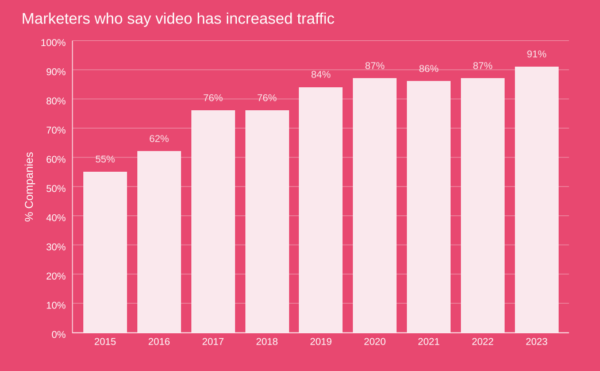
Now, each aspect–brand awareness, good ROI, increased traffic, and the understanding of products/services offered—is crucial for an effective advertising campaign. These are just some of the benefits video advertising can offer.
Alvils Karlštrems, Head of Ad Operations at Setupad: “Video ads are a powerful monetization tool, offering significantly higher CPMs due to their engaging nature—8 to 11 times more than banner ads. However, they tend to have a lower fill rate (approx. 10-20%). Despite this, video ads’ high effectiveness and complementary nature make them valuable to any advertising strategy.”
How Programmatic Video Advertising Works?
Programmatic video advertising involves automated, data-driven processes that select and display video ads to users in real-time, making ad delivery more efficient and targeted than traditional methods.
Generally, video ads within the programmatic world work similarly to other programmatic advertising types.
Programmatic Video Ad Buying Explained
Here are 6 simplified steps to show you how programmatic video advertising works:
- A user visits a website (the publisher’s site).
- As soon as the user lands on the site, an automated auction (RTB auction) begins for the ad space on the webpage.
- Advertisers interested in showing their video ads to users place bids for the ad space. These bids are processed through a programmatic platform that automatically handles them.
- The programmatic platform uses user data (e.g., browsing history, location, etc.) to help advertisers decide how much to bid.
- The highest bid wins the auction. The winning advertiser’s video ad is selected to be shown to the user.
- The programmatic platform determines the best time and format to display the video ad for maximum effectiveness. The video ad is then delivered and displayed in real-time to users as they browse the website almost instantaneously.
Types of Programmatic Video Advertising
Real-time bidding (RTB)
Ad slots are open to everyone in real-time bidding, and they’re sold through an open auction type of bidding, in which the highest bidder gets the spot in real-time.
Private marketplaces (PMP)
Private marketplaces operate similarly to RTB auctions but are available to advertisers on an invite-only basis. In PMP auctions, publishers usually set aside premium ad inventory for selected advertisers.
Programmatic Direct
Programmatic direct, also known as programmatic guaranteed, follows the traditional approach to media buying. The parties negotiate the terms one-on-one, and the inventory is sold directly to the publisher after the negotiation.
Preferred deals
Advertisers choose the ad inventory at a fixed price in preferred deals before it becomes available on PMPs or open auctions. Both parties (publishers and advertisers) agree on the pricing, targeting, etc., before the deal, so the advertiser gets a sneak peek into the publisher’s ad inventory without being bound to make any purchase.
Programmatic Video Ad Types
In-stream video ads
Instream video ads appear pre-roll, mid-roll, or post-roll pre-existing video content. Usually, the viewer can skip the ad after 5 seconds, but sometimes the viewer may need to watch the full video.
Pre-roll ads: These are played before the content the user has selected to watch. Pre-roll ads are quite common and can be found on video platforms like YouTube.
Mid-roll ads: These ads appear in the middle of the video content, similar to traditional TV commercial breaks.
Post-roll ads: These are shown after the video content has finished.
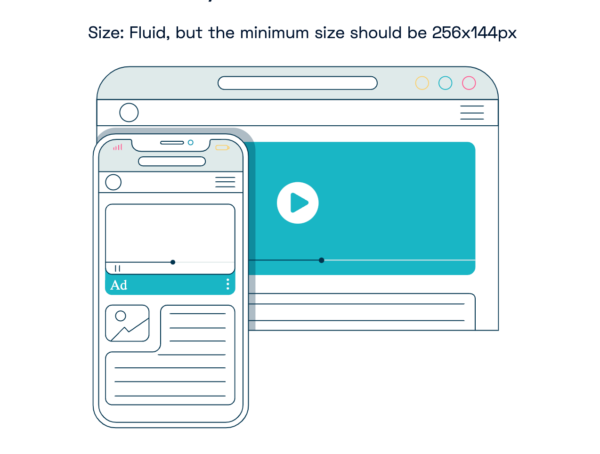
Outstream video ads
Outstream video ads are placed on publishers’ inventory (typically between paragraphs of text) and served outside of a video player. They’re called “outstream” because the video exists outside of content.
In-banner video ads: These are embedded within display banners and found on websites rather than within video content.
In-article video ads: These ads auto-play when they become visible on the user’s screen, usually within the content of a webpage.
Interstitial video ads: Full-page video ads that appear before or after an expected content page are displayed.
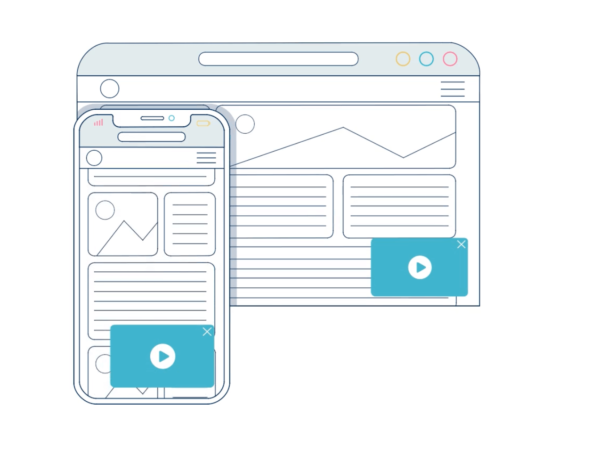
In-game (playable) video ads
In-game ads offer a high engagement rate because they’re interactive. Users can test out a game through the ad during their ad break. These ads also have high CTRs and a greater chance of user conversion.
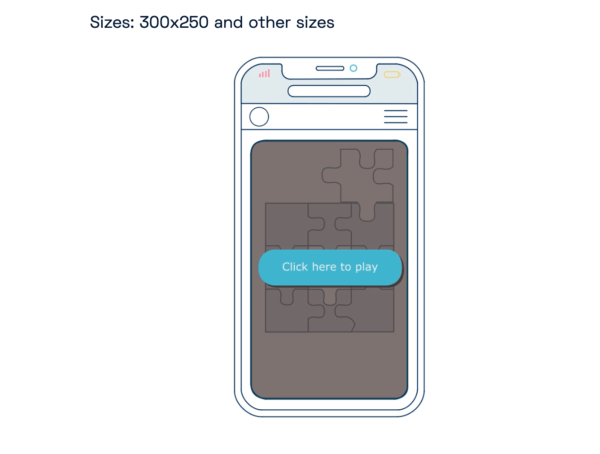
Rewarded video ads
Rewarded video ads offer users incentives, such as in-game currency or premium content, in exchange for watching a video ad, resulting in higher completion rates and improved user engagement.
This ad format enhances the user experience by providing value. It also serves as an effective monetization strategy for app developers and publishers due to its high engagement and targeted nature.
Based on the data from our network, rewarded video ads show one of the best performances among video formats!
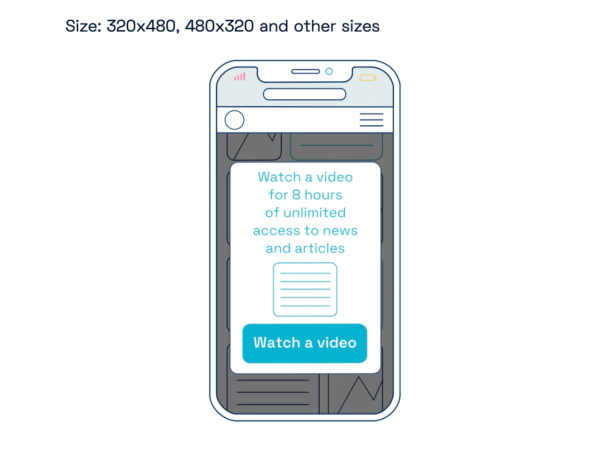
Key Components of Programmatic Video Advertising
| Purpose | Function | End-users | |
| SSPs | Enables publishers to sell their ad inventory across different ad exchanges. | Runs a real-time auction, serves the ad, and brings together inventory, multiple ad networks, ad exchanges, and DSPs. | Publishers |
| DSPs | Enables advertisers to buy ad space across several different ad exchanges simultaneously. | Helps advertisers to leverage audience targeting and optimize various campaigns. | Advertisers |
| DMPs | Collects, analyzes, and manages data to inform ad targeting and campaign decisions. | Aggregates data from various sources, segments audiences, and provides insights to improve ad targeting and effectiveness. | Advertisers and publishers |
| Ad Exchanges | Facilitate the auctioning process where DSPs bid on behalf of advertisers for the ad inventory supplied by the SSPs. | Uses algorithms to run auctions in milliseconds, determining which ad will fill the available slot on the publisher’s property based on the highest bid and the best match for the publisher’s criteria. | Advertisers and publishers |
Demand side platforms (DSPs)
DSPs enable advertisers to purchase publishers’ digital ad space automatically through ad exchanges. Google Display & Video 360, Xandr, MediaMath, and Adobe Advertising Cloud are among the most popular DSPs in the ad tech industry.
They allow advertisers to identify and pick their target audience and submit the ads they want to publish. Publishers use ad exchanges and SSPs to make their ad inventory accessible to the DSP. These platforms provide the ad impressions to the DSP, which decides whether to send a bid depending on how well it matches the targeting parameters.
Advertisers compete for the ad impression by making real-time bids. After the DSP buys the impression, the ad is displayed on the publisher’s website.
Supply-side platforms (SSPs)
A supply-side platform enables publishers to offer their ad space for purchase anytime. With SSPs, publishers can reach a large audience without having to negotiate with each advertiser individually.
Some of the most popular SSP companies are OpenX, Xandr, and PubMatic. Some companies (e.g., Xandr) combine SSP and DSP, others even integrate an SSP, a DSP, and a DMP (e.g., Adform).
Data management platforms (DMPs)
Data management platforms help to gather, arrange, and analyze data. This information can come from the ad buyer’s first-party and third-party data sources.
On the publisher’s side, this might contain both on-site behavioral and first-party data from their users. DMPs can leverage the data sources to produce anonymized profiles that DSPs and SSPs can employ.
DMP examples include Nielsen, Lotame, Oracle, and Salesforce Audience Studio.
Ad Exchanges
Ad exchanges are in the middle of the programmatic ecosystem–where DSPs and SSPs meet to negotiate a price and trade inventory.
Note: ad networks and ad exchanges are frequently confused.
- Ad network is a platform that collects and offers inventory from various in-network publishers.
- Ad exchange is a technology platform where buyers and sellers connect to sell and purchase ad inventory.
Leveraging OTT and CTV Platforms for Enhanced Programmatic Video Advertising
Over-the-top (OTT) services and Connected TV (CTV) platforms are becoming increasingly vital in programmatic video advertising, a trend driven by significant shifts in audience behavior regarding television and video content consumption.
Traditional television viewership is declining as more people turn to streaming services. This has expanded the advertising potential beyond conventional broadcast methods to more targeted and interactive environments.
OTT and CTV use user data to facilitate highly targeted ads. These platforms can track user interactions, preferences, and viewing habits in ways traditional TV cannot, allowing audience segments to be personalized ads to specific audience segments.
Understanding OTT and CTV
- OTT refers to media services that provide streaming content directly over the internet, bypassing traditional broadcasters, cable, or satellite platforms. Examples include streaming platforms like Netflix, Hulu, and Amazon Prime Video.
- CTV refers to any television set that connects to the internet and can stream digital video at the viewer’s convenience. This includes smart TVs and televisions hooked up to devices such as Roku, Apple TV, or Amazon Fire Stick.
Relationship with Programmatic Video Advertising
Expansion of Programmatic Advertising
Both OTT and CTV platforms enable advertisers to reach audiences moving away from traditional TV. These platforms collect user data, allowing advertisers to target specific demographics, interests, and viewing habits, making programmatic video advertising highly effective.
For publishers, this means higher revenue potential through increased demand and CPMs for their video ad inventory, improved audience reach, and enhanced monetization opportunities.
Advanced Measurement and Analytics
Both CTV and OTT provide advanced capabilities for measuring viewer engagement and ad performance. These include metrics on viewing time, interactions, and conversions, enabling advertisers to fine-tune their campaigns in real-time. Advertisers can further leverage these platforms’ data through programmatic technology for more precise targeting.
- For example, based on viewing behavior, advertisers can target ads to specific audience segments, such as sports enthusiasts on a sports streaming service.
Enhanced Viewer Experience
Programmatic advertising on OTT and CTV can enhance the viewer experience by delivering more relevant ads. Since the content is delivered online, ads can be personalized to the viewer’s preferences and previous behavior, potentially increasing engagement and effectiveness.
Benefits of Programmatic Video Advertising
Here are the 7 main benefits of programmatic advertising:
- Detailed targeting. Programmatic ensures highly relevant impressions by leveraging detailed demographics for better targeting.
- Higher effectiveness. More effective at achieving desired conversions due to precise targeting.
- Better engagement on mobile. More people watch video ads to the end on mobile devices compared to computers.
- Increased sharing. Users are more likely to share interesting or valuable video ads on social media, increasing reach.
- Great for informing and educating. Ideal for product demonstrations and how-to guides.
- Better storytelling. Videos tell a story better than other formats, enhancing ad recall and creating a more personal connection.
- Higher CTRs and CPMs. Video ads typically achieve higher CTRs and CPMs because they are more engaging and effectively capture user attention, leading to better performance and higher revenue.
Drawbacks of Programmatic Video Advertising
Ad load times and user experience
Programmatic video ads can sometimes lead to longer load times, negatively impacting user experience. Slow-loading ads can frustrate viewers, leading to higher bounce rates and decreased engagement. This affects users and undermines the ads’ effectiveness for advertisers and publishers, potentially reducing overall revenue and user retention.
Ad fraud
Ad fraud remains a significant challenge in programmatic video advertising. Fraudulent activities such as fake traffic, bot clicks, and domain spoofing can result in wasted ad spend and reduced campaign effectiveness. Advertisers must invest in advanced fraud detection and prevention measures to mitigate these risks, which can increase overall costs.
Technical complexity
Programmatic video advertising involves sophisticated technology and requires a deep understanding of various platforms, algorithms, and data analytics. The technical complexity can be overwhelming for publishers and smaller advertisers, necessitating investment in specialized skills or third-party services. This can increase operational costs and create barriers to entry for those without the necessary expertise.
That’s why partnering with a trusted third-party partner like Setupad can be beneficial.
Allow us to manage the technical aspects for you, seamlessly monetize your content, and unlock new revenue streams from video ads so you can easily focus on content creation!
Tips and Trends for Effective Video Advertising Strategy
Here we’ve gathered our main 7 tips for a more effective and powerful video advertising strategy:
- Sound strategy. Many viewers engage with videos with the sound off. Ensure your content is informative without sound and delightful with it. Include captions to enhance accessibility.
- SEO optimization. Optimize your video content for search engines to attract organic traffic. Understand where and what your audience is searching for—whether in Google, TikTok, or YouTube—and tailor your content accordingly.
- Interactive videos. Engage your audience by incorporating interactive elements in your video ads. Shoppable video ads, for example, allow users to explore products directly from the ad.
- Mix ad formats. Combine video ads with other formats for a comprehensive approach. This can enhance engagement, broaden reach, and improve ROI by catering to diverse user preferences and complementing the strengths of each format.
Alvils Karlštrems, Head of Ad Operations at Setupad: «Integrating banner ads together with instream ads can enhance the overall revenue without saturating the page with an excessive amount of banners which can lead to CPM devaluation. Instead of adding more banners (if a website is well-covered with ads), a strategic approach would be to add an instream video ad, thereby creating additional revenue while maintaining the value of banner ad impressions»
- Short-form videos. Capitalize on the popularity of short-form content like TikTok, Instagram Reels, and YouTube Shorts. Keep your video ads concise and engaging to capture attention quickly.
- Long-form videos. Utilize platforms like YouTube for longer content. Long-form videos are ideal for detailed explanations, podcasts, and recaps, allowing for thorough audience education.
Note: YouTube is the leading video marketing platform, with 90% of video marketers relying on the world’s top video site to reach their audience effectively.
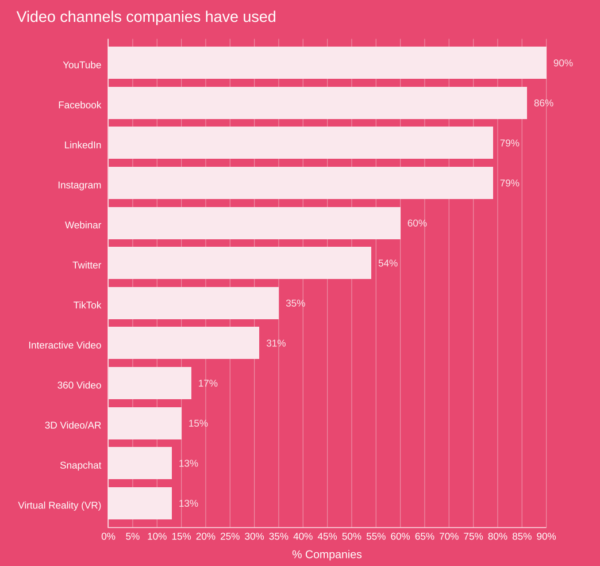
Source: Wyzowl
- CTV and OTT platforms. Leverage the shift from traditional TV to streaming services. Tailor your video ads for CTV devices with high-quality images, sound, and compelling CTAs. Integrate CTV advertising into your omnichannel strategy for a cohesive brand message across platforms.
Summary
Programmatic video advertising has become one of the most effective advertising strategies due to its ability to enhance ad relevance and user engagement. For users, this means more personalizedcontent, for publishers, higher revenue potential and improved monetization of their content, and for advertisers–efficient ad placements with a greater ROI.
Programmatic video advertising promises even greater sophistication with AI and machine learning, further enhancing targeting precision and campaign performance. As the programmatic world evolves, video ads promise greater precision and effectiveness, making them indispensable for staying competitive in the digital landscape.
FAQs
What are the main differences between programmatic video advertising and traditional video advertising?
Programmatic video advertising uses automated, data-driven technology for real-time ad placements, while traditional video advertising relies on manual processes and predetermined ad slots.
How does programmatic video ensure ad relevance and user engagement?
The programmatic video uses advanced targeting algorithms and real-time data to deliver personalized ads based on user behavior, demographics, and preferences, ensuring higher relevance and engagement.
What are the expected costs associated with starting programmatic video advertising?
The costs can vary widely depending on factors like the platform, targeting options, and ad formats, but initial investments typically start from a few thousand dollars for smaller campaigns to much higher budgets for extensive, highly targeted campaigns.
How can advertisers safeguard against ad fraud in programmatic video?
Advertisers can use tools like fraud detection software, work with reputable platforms, and implement measures such as whitelisting and blacklisting to minimize the risk of ad fraud.
What future developments can we expect in programmatic video technology?
Future developments may include enhanced AI-driven targeting, increased use of first-party data for personalization, greater integration with emerging technologies like VR and AR, and more robust anti-fraud measures.


